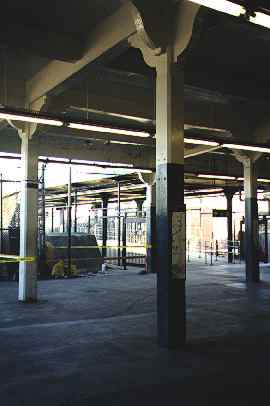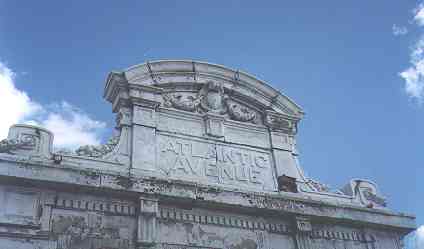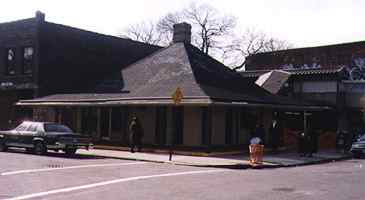Some NYC subway stations actually have above-ground station buildings. Quite frequently these houses will appear at subway stations that have been parts of actual railroad lines in the past, such as the D line between Sheeepshead Bay and Avenue H, or the #5 between 180th St. and Dyre Avenue.
Other times, though, a station house was placed at a subway station thought to be an important one or one where several lines met.
The Rockaway Park station was the terminus of the New York, Woodhaven and Rockaway railroad and boasted a gradiose terminal on Beach 116th Street between 1882 and 1917 that was complete with a private suite for the railroad’s prseident.
It was demolished in 1917 to make way for this more sedate brick building. The railroad became first a part of the LIRR and the trackage was sold to the NYC transit system in 1954; the building is now the terminus of the A train.
The Rockaway Park subway station still bears signs of its former LIRR lineage. Canopies like this are fairly common on the older LIRR stations, but rare for subways.
The Rockaway Park station has an unusual canopy supported by fluted columns toward the rear.
The Atlantic Avenue (D,Q)/Pacific St (B,M, R) station (two pictures at right) at Atlantic, Flatbush and 4th Avenues has boasted a Beaux Arts station with fine stonework for close to 90 years. Unfortunately, the surrounding area has deteriorated around it until presently, the station lies forlorn in an abandoned traffic island. Until the 1980s it had had to endure the ignominy of various fast food joints surrounding it and blocking off the detailed stonework.
Happily, this proud doyenne of Times Plaza has been rehabilitated and is preserved as part of a revived mini-transit hub here as a new LIRR terminal has been constructed across Flatbush Avenue.
Detail of the 1908-1910 vintage Beaux Arts stonework.
Above is a photo of the Avenue H stationhouse, Brighton Beach Line (currently D/Q) c.1905, before it was used as a stationhouse. It was the T.B. Ackerson Co. real estate office for Fiske Terrace, the attractive development of houses running north from Avenue H. The Avenue H station opened in 1907.
This is how the stationhouse at Avenue H looks today.
The present D line tracks between Prospect Park and Brighton Beach were originally a part of the Brooklyn, Flatbush, and Coney Island Railroad, which ran between Prospect Park and the Brighton Beach Hotel. It later gained and lost a connection to the LIRR at Atlantic Avenue, and became a part of the Brooklyn Rapid Transit Company (BRT) by 1900.
For more information on this venerable building please seerapidtransit.net.
Closeup of the front porch (How many NYC subway stations have porches?) Imagine some carriages alighting here and discharging train passengers… they did!
Exterior and interior of the Bowling Green station house, which serves the #4 and #5 IRT subway lines. This station has been open since the early days of the subway, having been completed by 1905 by the architectural firm of Heins & LaFarge, which built the very first subway line. Another original station house on the line is at 72nd Street and Broadway; it is slated for renovation to expand its narrow platform and stairs in the near future. Note the remains of the “Entrance” sign on the interior. The same style fancing can be seen in the 33rd Street Station, also an original IRT station.
These two station houses, on Beverl(e)y and Cortelyou Roads, were opened in 1907 and are only a block apart. They have been extensively renovated in recent years and boast picture windows directly over the tracks.

 The Dyre Avenue line in the Bronx, formerly the New York, Westchester and Bronx Railroad, boasts several station houses left over from the railroad days. Here’s the Pelham Parkway station at the Esplanade.
The Dyre Avenue line in the Bronx, formerly the New York, Westchester and Bronx Railroad, boasts several station houses left over from the railroad days. Here’s the Pelham Parkway station at the Esplanade.
No railroad, you say? Here the N.Y.W.&B. (er, the #5 train) enters a brief tunnel.

 The Morris Park station, built on a high ridge, boasts some nice Spanish Colonial style touches. It was built in 1912.
The Morris Park station, built on a high ridge, boasts some nice Spanish Colonial style touches. It was built in 1912.
1/15/99


















